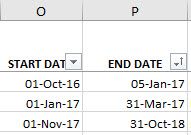Hi Excel Community,
I consider myself an advanced user of Excel but even this formula has me a little stumped. I have a data sheet with various lines of contracts with varying contract term dates (start and end). Three different scenarios - start in 2016 and end in 2017, start in 2017 and end in 2017, start in 2017 and end in 2018.
I need to calculate the number of 2017 months in all scenarios. I think my formula needs to be like this:
If start date year does not equal 2017 and end date year equals 2017 then calculate # of months end date has in 2017.
Otherwise, if start date year does equal 2017 and end date equals 2018 then calculate # of months start date has left in 2017.
Here is the formula I started building but it is not giving me what I am looking for:
=(YEAR(P2)-YEAR("1/1/17"))*12+MONTH(P2)-MONTH("1/1/17")
Here is a screeshot sample of data:

Any ideas or help will be greatly appreciated.
Thanks,
Dominica Smith
I consider myself an advanced user of Excel but even this formula has me a little stumped. I have a data sheet with various lines of contracts with varying contract term dates (start and end). Three different scenarios - start in 2016 and end in 2017, start in 2017 and end in 2017, start in 2017 and end in 2018.
I need to calculate the number of 2017 months in all scenarios. I think my formula needs to be like this:
If start date year does not equal 2017 and end date year equals 2017 then calculate # of months end date has in 2017.
Otherwise, if start date year does equal 2017 and end date equals 2018 then calculate # of months start date has left in 2017.
Here is the formula I started building but it is not giving me what I am looking for:
=(YEAR(P2)-YEAR("1/1/17"))*12+MONTH(P2)-MONTH("1/1/17")
Here is a screeshot sample of data:
Any ideas or help will be greatly appreciated.
Thanks,
Dominica Smith





